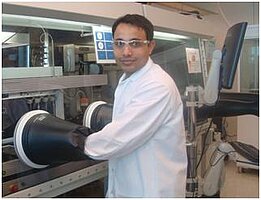Ion Imprinted Polymer for Removal and Monitoring of Arsenic

Harjyoti Kalita is a third-year graduate (PhD) student in Materials and Nanotechnology program at North Dakota State University (NDSU). He started his graduate degree in Fall, 2007. He did his M.Sc. in Chemistry (2006) from Indian Institute of Technology (IIT) Guwahati, India. During his master degree he did some research work on catalyst preparation and their applications. Harjyoti did his bachelors of science majoring in chemistry from Gauhati University, India (2004).His research work focuses on the synthesis of ion-imprinted polymer to remove arsenic from water.
Email: Harjyoti.Kalita@ndsu.edu
Phone # 701-200-5109
Fellow: Harjyoti Kalita
Advisor: Achintya Bezbaruah, Ph.D., Assistant Professor, Department of Civil Engineering, North Dakota State University.
Co-Advisor: Bret Chisholm, Ph.D., Senior Research Scientist, Center for Nanoscale Science and Engineering and Adjunct Professor, Polymers and Coatings, North Dakota State University.
Matching Support: North Dakota State University.
Degree Progress: Ph.D. in Environmental Engineering expected in Fall 2011
Ion Imprinted Polymer for Removal and Monitoring of Arsenic
Project Objectives:
- Preparation of an ion-imprinted polymer (IIP) for selective removal of arsenic.
- Selectivity study of the IIP in presence of different ionic particles
- Determination the reusability of the IIP prepared
- Preparation of a new ion-imprinted sensor for aqueous arsenic
Research:
Arsenic is a very toxic element for human and on other living organisms. The threat of arsenic pollution in drinking water is a serious environmental and health concern. In drinking water supplies, arsenic occurs naturally although some pesticides and preservatives also may contribute arsenic. The U.S. Environmental Protection Agency (U.S. EPA) has lowered (2006) the maximum containment level (MCL) for arsenic in drinking water to 10 parts per billion (ppb) from earlier 50 ppb. This new MCL i.e. 10 ppb has created an urgent need of low capital and less technology intensive processes for arsenic removal and sensing in water, more particularly in small utilities and rural communities. Arsenic contamination is still a major problem in many parts of the world. Even at low level arsenic exposure various skin lesions appear. These are marked by hyperpigmentation (dark spots), hypopigmentation (white spots) and keratoses of the hands and feet. Continued exposure leads to skin cancer. Ingestion of arsenic is blamed for lung, kidney, liver and bladder cancer.
Arsenic is present in water in both tri- and penta-valent forms. Various processes are presently used to remove arsenic from water. However, most of the conventional arsenic removal processes can’t remove As(III) and As(V) simultaneously. They can treat either As(III) or As(V), and, hence, a pretreatment in the form of oxidation or reduction is needed. The need for an additional unit process adds to the capital and operation costs of treatment.
To overcome this limitation we proposed here a new technology i.e. synthesize of ion-imprinted polymer for the removal of both As(III) and As(V) simultaneously. There various types of solid phase extraction method but, ion imprinted polymers (IIP) are potential candidates with high probability of success. Different cross-linkers are used in the polymer which can bind both As(III) and As(V) and reduce As(V) to As(III). This research will proceed further on to develop sensors with low response time and high arsenic detection efficiency.
The work proposed here is the continuation of 2009 NDWRRI program.
Progress:
The progresses made during the last year are summarized below:
Task I- Thiol- arsenic complex was synthesized and solid white colored thiol- arsenic complex compound was found
Task II- The complex formed in Task I was imprinted in styrene-divinyl benzene copolymer. FT-IR was taken for the polymer which again illustrated that arsenic is still bound to the polymer.
Task III- The dried polymer (from Task II) was mixed with 6 M HCl for 6 hr to leach the arsenic from the polymer. Arsenic came out from the polymer leaving the As imprints (i.e., void spaces of the As ions). Such spaces are specific to arsenic only.
Task IV- ICP-OES analysis was carried out to see the binding and elution of arsenic to/from the polymer during the synthesis of the IIP of arsenic. Sorption and elution of arsenic was optimized from ICP-OES analysis. All these analysis were carried out in ppm level. Now our target is to analyze in ppb level.
Research Outputs from 2009 Fellowship Program:
Kalita, H., Chisholm, B. J., Bezbaruah, A. N. Synthesis of Ion Imprinted Polymer to Remove Arsenic from Water, ND EPSCoR State Conference, September 2009, Fargo, North Dakota. (Poster Presentation)
Krajangpan, S., Chisholm, B. J., Kaita, H., and Bezbaruah, A. N. Challenges in Groundwater Remediation with Iron Nanoparticles: Enhancement Colloidal Stability (Chapter 8) in Nanotechnologies for Water Environment Applications (Eds: Zhang, T., Surampalli, R.; Lai, K.; Hu, Z.; Tyagi, R.; Lo, I.), Environmental and Water Resources Institute/American Society for Civil Engineers, 2009, 191-212. (Book Chapter)
Kalita, H., Chisholm, B. J., Bezbaruah, A. N. Effects of different graft copolymer constituent groups on sedimentation characteristics of coated iron nanoparticles, PMSE Preprints, 2009, 100, 683-685.
Kalita, H., Chisholm, B., J., Bezbaruah, A., N. Ion-imprinted Polymers: A new Approach to Remove Arsenic from Drinking Water. AWWA, Surface Water Conference, April 2008, Moorhead, MN. (Poster Presentation)
Significance:
This new technology will be very efficient to remove arsenic from water and will be very relevant to North Dakota. The U.S. EPA conducted a five year review (2004-2008) to analyze the remedial action implemented in South-eastern North Dakota. Approximately 375 wells in the 26 townships (about 568 square miles) were sampled and it was found that more than 84% samples have the arsenic concentration above the MCL. Again, there are approximately 4,000-5,000 out of about 74,000 other community water systems that are violating the new MCL and they are serving 11 million people nationwide. This new ion-imprinted technology can be use in large and small water treatment plants including point-of-use treatment units to remove arsenic from drinking water. Ion-imprinted chemical sensor technology will have potential applications detecting arsenic precisely up to MCL level efficiently and very quickly at low cost.

Achintya Bezbaruah
Civil & Environmental Eng.
Office: Civil/Ind Eng 201G
Telephone: 701-231-7461
Email: a.bezbaruah@ndsu.edu

Bret Chisholm
Center for Nanoscale Science and Engineering
NDSU


